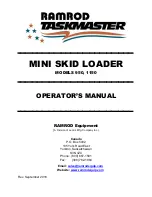
Technical Data
Fluids, Lubricants and Capacities
178
9821/6100-4
178
•
'NATO F34 (MIL-OTL-83133E)', 'NATO F35 (MIL-OTL-83133E)', 'NATO JP8 (MIL-OTL-83133E)', 'NATO
F-44 (MIL-OTL-5624U)', 'NATO JP5 (M IL-OTL-5624U)', 'Jet A (ASTM 01655)', 'Jet A1 (ASTM 0 1655)'
All the above fuels can only be used if the sulfur level meets the specifications that are listed in the Refer to Table
25., Refer to Table 26.. An analysis of a sample of fuel must be conducted in order to check the sulfur level.
These fuels are only acceptable provided that these fuels are used with an appropriate fuel additive. These
fuels must meet the requirements that are stated in the Refer to Table 25., Refer to Table 26., Refer to Table
27.. Fuel samples should be analyzed for the compliance. These fuels must not exceed lubricity wear scar
diameter of 0.46mm. The fuel lubricity test must be performed on a HFRR, operated at 60°C (139.9°F). Refer
to 'ISO 12156-1'. Fuels must have minimum viscosity of 1.4 centistokes that is delivered to the fuel injection
pump. Fuel cooling may be required in order to maintain minimum viscosity of 1.4 centistokes that is delivered
to the fuel injection pump.
Group 4 Biodiesel
The biodiesel is a fuel that can be defined as mono-alkyl esters of fatty acids. Biodiesel is a fuel that can be
made from a variety of feedstock. The most commonly available biodiesel in europe is REM (Rape Methyl
Ester). This biodiesel is derived from rapeseed oil. SME (Soy Methyl Ester) is the most common biodiesel in
the US. This biodiesel is derived from soybean oil. Soybean oil or rapeseed oil are the primary feedstocks.
These fuels are together known as FAME (Fatty Acid Methyl Esters).
Raw pressed vegetable oils are not acceptable for use as a fuel in any concentration in compression engines.
Without esterification, these oils gel in the crankcase and the fuel tank. These fuels may not be compatible with
many of the elastomers that are used in engines that are manufactured today. In original forms, these oils are
not suitable for use as a fuel in compression engines. Alternate base stocks for biodiesel may include animal
tallow, waste cooking oils, or a variety of other feedstocks. In order to use any of the products that are listed
as fuel, the oil must be esterified.
Engines that are manufactured by Perkins are certified by use of the prescribed EPA (Environmental Protection
Agency) and european certification fuels. Perkins does not certify engines on any other fuel. The user of the
engine has the responsibility of using the correct fuel that is recommended by the manufacturer and allowed
by the EPA and other appropriate regulatory agencies.
Recommendation for the Use of Biodiesel
The neat biodiesel must conform to 'EN14214' or 'ASTM 0675' regulations. A maximum of 10% mixture of
biodiesel can be used in mineral diesel fuel. The mineral diesel fuel must conform to 'EN590', 'ASTM 0975' or
'8S2869 Grade A2' regulations. In North America, biodiesel and mixtures of biodiesel must be purchased from
the 809000 authorized manufacturers and 809000 certified distributors. In other areas of the world, the use of
biodiesel that is authorized and certified by an appropriate biodiesel quality body is required.
When biodiesel, or any blend of biodiesel is used, the user has the responsibility for obtaining the proper
local exemptions, regional exemptions, and/or national exemptions that are required for the use of biodiesel
in any Perkins engine that is regulated by emissions standards. Biodiesel that meets 'EN14214' is acceptable.
The biodiesel must be blended with an acceptable distillate diesel fuel at the maximum stated percentages.
However, the following operational recommendations must be followed:
•
The oil change interval can be affected by the use of biodiesel. Use services oil analysis in order to monitor
the condition of the engine oil. Use services oil analysis also in order to determine the oil change interval
that is optimum.
•
Confirm that biodiesel is acceptable for use with the manufacturer of the fuel filters
•
In a comparison of distillate fuels to biodiesel, it provides less energy per gallon by 5% to 7%. Do not
change the engine rating in order to compensate for the power loss. This will help to avoid the engine
problems when the engine is converted back to 100% distillate diesel fuel.
•
The compatibility of the elastomers with biodiesel is being monitored. The condition of seals and hoses
should be monitored regularly.
•
Biodiesel may pose low ambient temperature problems for both storage and operation. At low ambient
temperatures, fuel may need to be stored in a heated building or a heated storage tank. The fuel system
may require heated fuel lines, filters, and tanks. Filters may plug and fuel in the tank may solidify at low
ambient temperatures if precautions are not taken. Consult your biodiesel supplier for assistance in the
blending and attainment of the proper cloud point for the fuel.
Summary of Contents for 2069289
Page 2: ......
Page 4: ...9821 6100 4 Notes...
Page 12: ...Notes viii 9821 6100 4 viii...
Page 18: ...Notes 6 9821 6100 4 6...
Page 30: ...Notes 18 9821 6100 4 18...
Page 45: ...Operation Windows 33 9821 6100 4 33 Figure 21 A B A Latch B Frame...
Page 98: ...Notes 86 9821 6100 4 86...
Page 207: ...Technical Data Warranty Information 195 9821 6100 4 195 Figure 154 11000h 132 Month h...
Page 208: ...Notes 196 9821 6100 4 196...





































